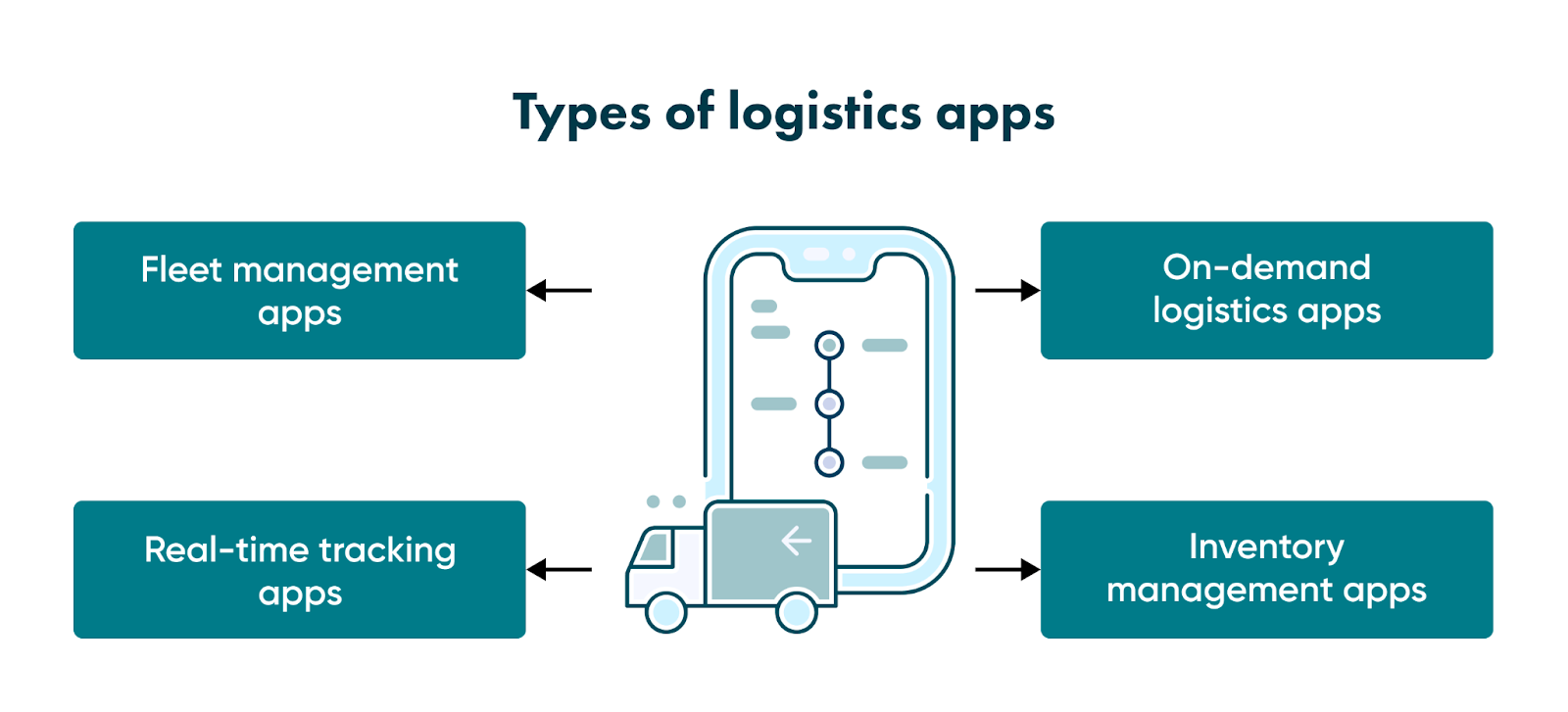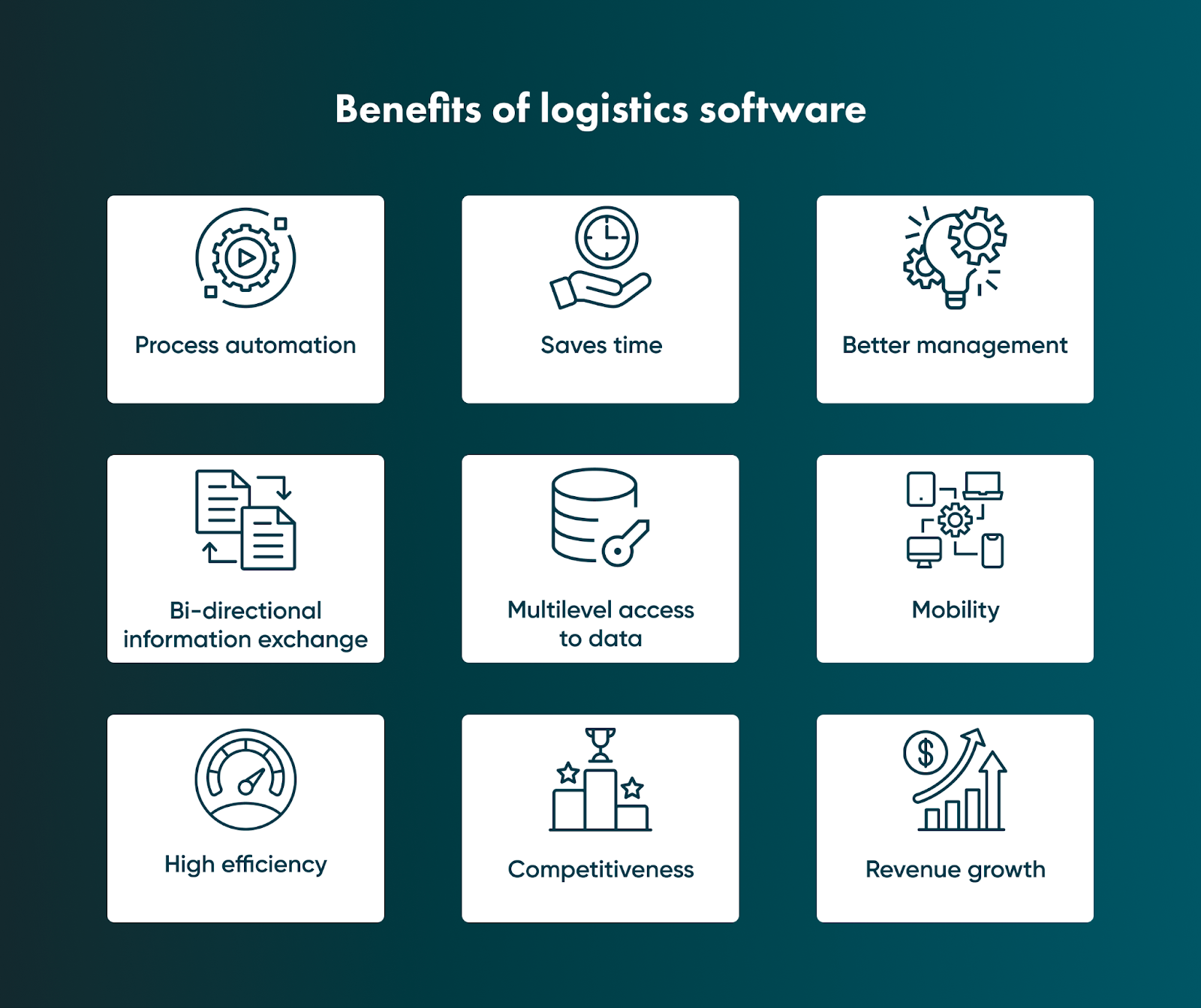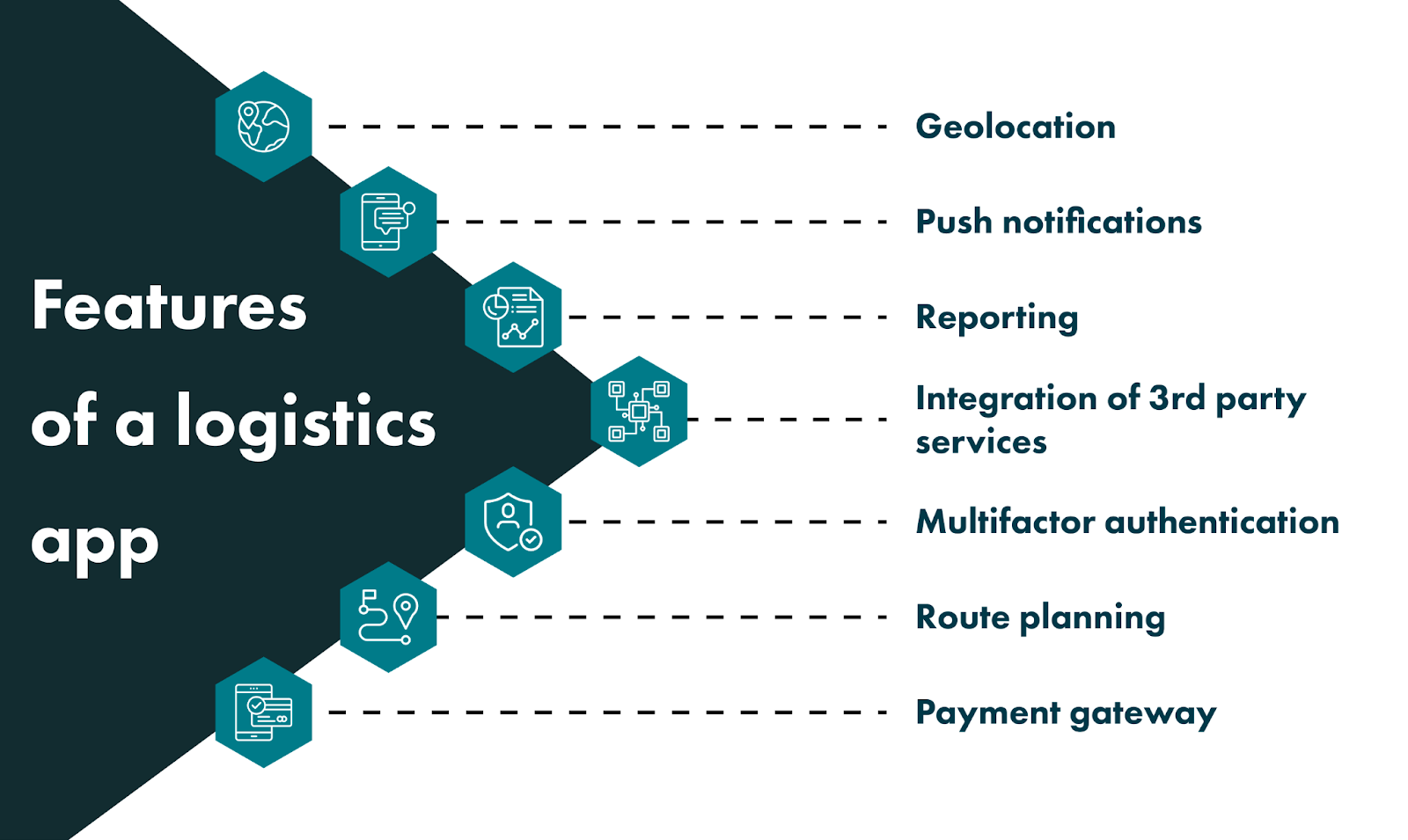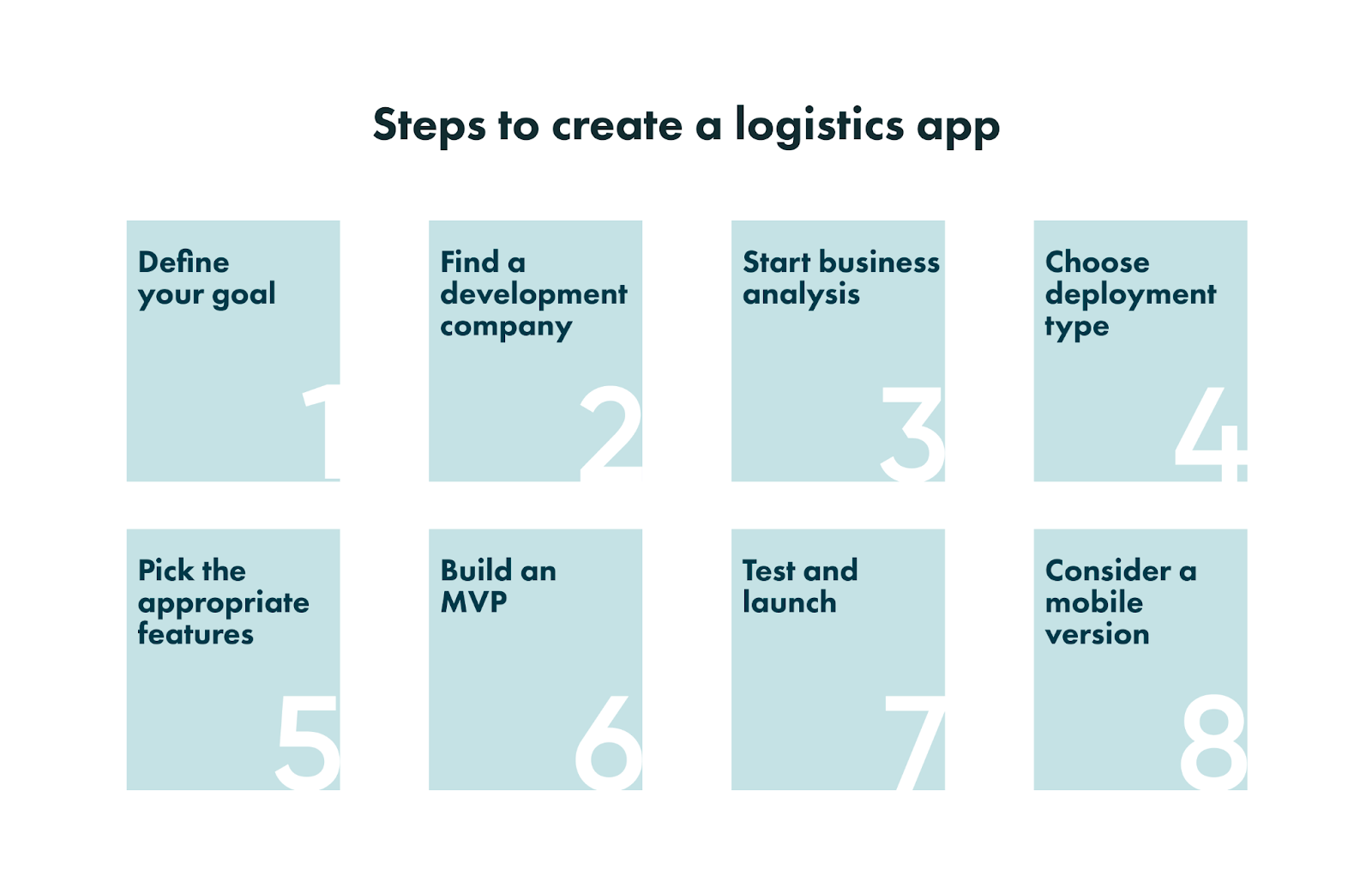A Logistics App Development Guide: The Benefits and Steps to Follow
Focusing on logistic app development is important for all organisations that transport goods. Yet there are many moving parts that make up an efficient logistics network, and a dedicated piece of software can be the glue that binds them together.
The logistics and transport management industry has features that make it necessary to look for ways to organise the most efficient and well-coordinated work using modern techniques.
Today, it virtually becomes impossible to deal with all the issues logistics companies face without software solutions. Therefore, you need to know the benefits and steps to build logistic software for your needs.
That is what we will cover in detail in this article, so read on to find out more.
Who needs logistics software?
A logistics app is a tool that can be used not only by logistics companies, but by a wide range of organisations.
Logistics apps help companies that ship and receive all types of cargo monitor and manage all the relevant processes. Simply put, logistics software contributes to the optimisation of actions that are necessary for the successful transportation of goods.
So, carriers, transportation companies, factories, workshops, and retailers can use logistics software – and this is just a partial list of potential users. Thus, logistics applications may also be valuable for customers as this type of tool gives them the ability to track their deliveries and stay updated throughout the shipping process.
Go Wombat can always provide a detailed consultation on when and how a transport and logistics app can be beneficial for your business. Contact our experts today to find out if a logistics app is the right choice for your business.
Types of logistics apps
Before we dive into the nuances of the logistics app development process, let’s go over the types of existing logistics apps.

Fleet management apps
This logistics application is appropriate for transportation companies with a fleet of vehicles for commercial transport or cargo shipment. In this scenario, a logistics app allows managers to track all information about trucks or buses and see updated data in real-time.
On-demand logistics apps
On-demand apps for logistics connect drivers and customers who need their cargo delivered to a specific destination.
Think rideshare apps – customers looking for a cargo delivery service nearby can order deliveries as needed.
Real-time tracking apps
Tracking logistics applications provide current locations, so customers, managers, and owners can see their vehicles' whereabouts and track their routes. Also, drivers can use tracking apps to navigate the different roads and reach their destination on time.
Inventory management apps
Warehouse and inventory tracking is necessary to manage the goods, deliveries, and warehouse space.
Just imagine how many goods can be stored in one warehouse (answer: hundreds of thousands). So, inventory management apps enable the tracking of the status of all pieces.
Let’s start building your logistics app. Contact Go Wombat today.
Benefits of logistics applications
Logistics apps can deliver a wide range of benefits to different types of organisations.

Here are some of the most common advantages of this type of software.
Process automation
This is the first reason why logistics software is advantageous. It automates many processes, and users can speed up the workflow, optimise multiple processes, and improve efficiency across the board.
Improved productivity
Logistics apps save time and make necessary logistics processes much faster. Which, in turn, can increase productivity throughout your business.
You can also get all updates about the exact location of vehicles and deliveries, making the process more transparent and ensuring that team members adhere to the correct route.
Better management
Through dedicated logistics software, you can continually improve warehouse management, control your inventory, and streamline supply-chain processes.
Besides, technologies like AI and IoT make management processes swifter and more accurate.
Bi-directional information exchange
As we mentioned earlier, trucking companies and logistics firms are not the only entities that can use this type of application. Consumers are also starting to seek out new ways to send or receive their own private cargo.
These consumers represent a growing segment within the market and a logistics app can help you sell your services directly to these individuals.
Multilevel access to data
With custom logistics apps, companies can provide different access levels to documents and information both for employees and customers. So, in addition to all the features listed above, you can choose who has access to what, based on their clearance level.
Mobility
One of the biggest advantages of logistics apps is that they can be accessed from anywhere in the world. It doesn’t matter if the client or managerial team are travelling, they will always have access to data about the deliveries being carried out.
A competitive advantage
If you establish a strong online presence, you will have an advantage over your competitors. However, remember that this application should be well-thought-out and user-friendly to become competitive.
Revenue growth
Finally, all the benefits mentioned above contribute to revenue growth. A more productive setup can help you attract more new customers and increase the number of recurring clients. At the same time, an app can make your company more accessible and help you optimise key processes — all of which lead to higher profit.
Critical modules logistics software should contain
Modules mean additional features necessary to achieve the main goals during logistics procedures. At the same time, it’s important to note that some of these modules can be skipped depending on your needs and the type of software.
Let’s take a look at some of the most common modules found in this type of software.
ERP system
ERP stands for enterprise resource planning, and it helps your company manage daily tasks like purchasing and accounting, simplifying the management process.
ERP systems can be used as independent software, but it’s also extremely convenient to include it as a module.
Warehouse management system
Another essential module is used to track the company’s inventory and manage distribution processes.
This module has the potential to become your team’s most important tool. In short, this module allows your employees to understand what is available in the warehouse and your facility’s availability, coordinate arrivals, and perform other essential tasks.
In addition, this module significantly simplifies and improves multiple processes, which are usually tedious due to the fact that supply-chain management is a complex multistage operation.
Fleet management and tracking
This module is commonly used to manage large fleets of vehicles and properly coordinate the movements of goods.
Of course, you want to ensure that all the goods are to be delivered successfully and on time, so this module is vital.
Data analytics
A data analytics module is required to obtain up-to-date statistics about each working day, week, month, and year.
This module allows you to analyse productivity and overall work results, compare progress for different periods, and assess and be prepared for potential issues.
Primary logistics app features
The next thing to consider is a feature list of your logistics application.
In this section, we’ll list the functionalities frequently used in logistics apps.
Remember, in your logistic software’s case, the number and types of features will depend on your requirements and the app’s characteristics.

Geolocation
Cargo tracking in real-time is necessary for business owners and customers.
The geolocation feature in logistics software enables this process and allows everyone to see the driver's current location, route, and next stop.
Push notifications
Users should always be notified about all shipment/delivery status changes and system, as well as receive news and messages via push notifications through the web or mobile device.
Calculation
Clients need to know how much the delivery will cost and the time estimated for delivery. The calculation feature helps them understand the precise cost and timelines before they sign up for the service. This feature can be fully tailored to your organisation’s requirements.
Reporting
It is necessary for employees to create reports in the logistics app based on all collected data. Detailed reports reduce their workload and help access all up-to-date information quickly. Moreover, storing all relevant documents in one application and finding them quickly is possible.
Integration with third-party services
Logistics web applications (and mobile apps as well) can be integrated with third-party services to modify the app’s functionalities and make it more versatile.
For example, accounting software and existing ERP systems can be integrated. Keep in mind that this step is not necessary if you already have built-in modules (more about this in a bit).
Multifactor authentication
Security measures come first if you want to prevent your logistics software from unauthorised access. You should add multi-factor authentication to your app to ensure that only the right users may log in.
Route planning
An integrated navigation system will help your company build an optimal route to deliver cargo within the shortest period. It also may require integration with a specific third-party navigation system.
Payment gateway integration
With the right custom logistics app you can use trustworthy payment services like Braintree, Stripe, and PayPal to accept online payments. Cashless payments have been the norm in the logistics industry for a while, so making this functionality easy to implement is key.
The development process for logistics apps can be complex, but you don’t have to take it by yourself — contact Go Wombat and schedule a consultation today.
Logistics web development: A step-by-step process
Now, let’s go over the meaty stuff: steps to logistics app development, whether it be mobile or web application.

Map out your goals
First of all, you have to determine the goals of your logistics software.
Your logistics application will have specific features and characteristics depending on your business type and unique requirements. But to determine what these are, you need to figure out what you want your app to do.
This may become a complex process, but you don’t have to take on the challenge on your own.
You can always work with an experienced logistics development firm from the inception stage and get your app built quickly and efficiently.
Having collected the required information for this step, you can move to the next step.
Find a reliable logistics app development company
Hiring a reputable software development company is a challenging task. That said, it’s an essential step, so you need to complete it if you haven’t already.
There are many companies around the world which provide development services, but not all firms adhere to a high-quality standard.
The good news is that you can look beyond your current market — outsourcing prevails today. We even have a detailed article that explains how to outsource your software development.
It’s important to review Clutch.co — a website with verified and objective ratings and reviews about different development companies. There you can see the top countries for outsourcing.
This article about how to outsource will tell you more.
If you’re in need of an advanced developing company, we’re here to help. Go Wombat has extensive experience in logistics app development, so contact us today to learn more.
Business analysis and discovery phase
Before going any further, it’s important to note that you can do this entire process independently.
But if you want to increase productivity and ensure that the end product is superb, our business analysts know all the secrets of how to do it properly.
Once we discuss all the nuances of the future logistics web development, we will proceed to the business analysis stage.
This stage includes the project discovery phase, market research, risk analysis and management, project planning and monitoring, requirements elicitation, strategy creation, and other crucial steps.
Our business analysts explore your business to understand its problems and critical processes, an essential step to speed up development and safeguard against financial loss.
Choose the deployment type
The next step is to choose the deployment type: cloud, on-premise deployment, or hybrid.
On-premise deployment means all software components are installed on your company’s servers and hardware. Your company is entirely responsible for its management and control.
Cloud deployment means your software is stored in cloud servers, and the cloud service provider controls its maintenance. This option is preferable and more frequently used today. It is a more flexible and reliable deployment type.
There are also hybrid environments that feature both cloud and on-premise. The format of this setup varies tremendously based on the needs of each company.
Select the features
As we mentioned before, the list of features for your logistics software will depend on your goals and requirements.
So here, you can pick the key features together with the development team to meet your app’s goals. Our business analysts, solutions architects, and other specialists will advise you the entire way, so you can make decisions with all the information available.
It is crucial to avoid useless features in order to keep costs low and productivity high.
Build an MVP
If you have a tight budget or want to validate your idea, you can start first with minimum viable product (MVP) development and testing.
In short, MVP consists of a piece of software with a minimum number of features required for the app to function. Therefore, it is a better option to test its functionality and determine what features are essential for a complete app.
Our development team creates logistics app design, both frontend and backend.
Test and launch
Regardless of what app version — an MVP or a full-fledged product — it should always undergo testing by QA engineers.
The QA department performs tests to ensure your app is stable, bug-free, and works correctly. The app should be suitable for launching once all tests are done.
Or, if it was created for internal purposes, your company should be able to start using it right away.
Make your app mobile-friendly
We highly recommend building a mobile-friendly logistics app.
Your app should have a responsive design to adapt to mobile devices' screens. The best option may be to create a cross-platform logistics mobile app for iOS and Android.
This will make your service user-friendly, potentially boost the number of orders generated through mobile, and increase customer loyalty.
Go Wombat has vast experience in mobile cross-platform app development, so schedule some time with our professionals today.
Wrapping Up
All organisations require a tailored strategy when developing a logistics app. This is the exact reason why we create a personalised plan for each one of our clients.
We can create a more accurate estimate based on your requirements after performing a detailed analysis of your case.
If you would like to find out more about collaborating with a professional logistics software development expert, we’re always here to help.
Need a detailed estimate of your software development? Contact Go Wombat.
Unlock Success with Premium Software Development
Contact us


FAQ
What is logistics software?
Logistics software is a tool that helps optimise and automate goods shipment and delivery with the goal of improving supply chain management.
There are many different types of logistics software, and each type aims to perform a specific range of tasks.
How to develop a logistics app?
The development process of a logistics app includes a variety of stages, including requirements gathering, hiring a development company, business analysis, choosing a deployment type, picking the feature list, building an MVP, testing and releasing.
However, some steps can be added depending on the app and your company’s requirements.
How is AI used in logistics?
There are many ways artificial intelligence can be used in logistics.
For example, AI helps enrich obtained data quality, uses predictive analytics to estimate the upcoming demand, and improves supply chain management with warehouse automation, among other complex tasks.
How can we help you ?





